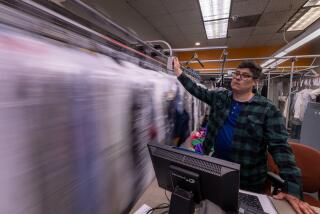Wet’s Going On?
Irene White used to avoid dry-cleaners because she couldn’t tolerate the solvents they used to clean her clothes.
“I had a sensitivity to the chemicals. I occasionally broke out in a rash, and I didn’t like the smell,” says White, a Huntington Beach resident.
Until recently, White was resigned to wearing cotton garments and other fabrics that didn’t have to be dry-cleaned; she hand-washed her sweaters and fine clothing.
Then, two months ago, a new cleaners called the Natural Valet opened in Huntington Beach. The Natural Valet uses no chemical solvents and claims to be the first cleaner in Orange County to use a wet-cleaning process that cleans clothes in water and biodegradable enzymes instead of chemicals.
Such so-called wet-cleaners, if they’re successful and if more of them open in the county and nationwide, could bring about the greatest change in garment care since the introduction of dry-cleaning in the 1930s.
After trying the Natural Valet, White is a dyed-in-the-wool wet-cleaning convert.
“It was wonderful. I put a sweater on over my head, and it was really fresh,” she says. Now she can wear fabrics besides cotton and have her wool sweaters dry-cleaned.
“I’m free,” she says.
Many people have grown accustomed to taking their fine clothes to a neighborhood dry-cleaner. While convenient and effective, most traditional dry-cleaners use a toxic solvent called perchloroethylene (PCE), or perc, for clothes and comforters.
Under the federal Clean Air Act, perc is a toxic chemical regulated by the U.S. Environmental Protection Agency because it is suspected of causing cancer and harmful effects to the nervous system such as dizziness, nausea, skin irritation and headaches. Those who work at a dry-cleaner are at greatest risk of exposure.
Marcello Villafane worked for years at a traditional dry-cleaner before going to work at the Natural Valet.
“Before, every day I had a headache. I smelled the perc. I’d go home and go to sleep early,” Villafane says. “Now I feel better.”
The public can also be exposed to perc, primarily through contaminated drinking water and residue on clothing. That telltale odor that clothes sometimes give off when they’re fresh from the cleaners is perc.
Consumers Union found that frequent users of dry-cleaning, those who wore the equivalent of one freshly cleaned jacket and blouse a week over a period of 40 years, had an estimated risk from perc of 150 cancer cases per million consumers--a risk it deemed “not trivial” considering the millions who use dry-cleaning services.
“Perc remains a hazardous air pollutant and a major water pollutant and threat to drinking water,” says Tim Carmichael, policy director for the Coalition for Clean Air in Los Angeles. “It has contaminated 10% of the wells in 37 counties across the state and remains a major problem in emissions. The difficulty is that the source of perc is a lot of small businesses.”
EPA regulations have caused many dry-cleaners to lower their perc emissions by upgrading machinery. Wet-cleaning eliminates the use of perc entirely.
Wet-cleaners use computerized cleaning machines that allow control of factors such as agitation and water temperature that can cause problems with fine fabrics such as silk.
“The reason perc was developed as a cleaning agent is it’s excellent at removing oil and grease-type stains without affecting the fibers that would swell and distort in water,” says Chris Dolan, sales manager of Iowa Techniques Inc. in Cedar Rapids, Iowa, distributor of Aquatex wet-cleaning systems. The garments are immersed in solvent that doesn’t penetrate the fibers, hence the name “dry-cleaning.”
“But water is more effective in removing water-based stains like food and perspiration, and it can remove grease stains with pre-treatment,” Dolan says. “Dry-cleaning solvents clean the surface [of the fiber], whereas water penetrates the surface.”
Results of wet-cleaning are “a matter of opinion,” says Dolan, but advocates maintain that wet-cleaners perform just as well as dry-cleaners.
“We’re showing there’s nothing you can’t wet-clean that you can dry-clean,” says Deborah Davis, owner of Cleaner by Nature in Santa Monica, a wet-cleaner participating in a UCLA Wet Cleaning Demonstration Project.
The project has found that, of 12,068 garments cleaned by Cleaner by Nature in its first six months of operation, 87 or 0.72% were returned by customers for additional work.
“Our complaint rate isn’t any higher than other cleaners,” Davis says. In addition, wet-cleaning does not melt plastic buttons and beading the way solvents can, she says. Traditional dry-cleaners usually have to remove such ornamentation when cleaning beaded wedding gowns and evening wear.
Many dry-cleaners remain skeptical of wet-cleaning’s ability to handle certain fabrics and oil-based stains:
“Some wools will have shrinkage, and consumers are going to scream,” says Lara Schneider, spokeswoman for the International Fabric Care Institute in Silver Spring, Md., a dry-cleaning association.
Wet-cleaners admit the new technology has drawbacks--it takes longer to press garments that have been wet-cleaned, increasing labor costs.
“There are still concerns about the cost effectiveness of wet-cleaning. There’s more hand-finishing of garments,” Schneider says. That’s one reason why the institute does not foresee a complete takeover by wet-cleaners.
“We see it as a good addition [to the cleaning field],” Schneider says.
Traditional cleaners have been slow to embrace the new technology. Of the approximately 30,000 dry-cleaners in the United States, only about 35 use a wet-cleaning system, according to Iowa Techniques. Of those, only 15 or 16 are stand-alone wet-cleaners--they use no solvents, as opposed to those who added a wet-cleaning system to existing dry-cleaning machinery.
Most who open stand-alone wet-cleaners are new to the cleaning business. Jonathan Grossman, owner of the Natural Valet, worked in the environmental business removing hazardous waste--including perc--before opening his wet-cleaner business. He says he likes ushering visitors around his plant, showing off his $40,000 wet-cleaning equipment and racks lined with cleaned comforters, evening gowns and blouses. He points out a child’s stuffed bear:
“Ordinarily a child would sniff it and get a tremendous whiff of perc,” he says.
To Grossman, improved worker safety is a major benefit of wet-cleaning. “If you’re in the dry-cleaning business, you’re breathing perc every day,” he says.
The Natural Valet picks up clothing from homes and offices throughout Orange County.
Grossman says his prices are based on averaging the cleaning fees charged by five of his closest competitors, “including discounters.” He charges from $3.50 to $4.50 to wet clean a woman’s blouse.
Many of Grossman’s customers, including White, have skin allergies triggered by dry-cleaning that went away when they switched to a wet-cleaners.
“This is really the wave of the future,” Grossman says. “We’re like pioneers in Orange County.”
In the end, it may be property owners who persuade dry-cleaners to switch to wet-cleaning.
“Property owners no longer want the liability of a solvent on their property,” Dolan says.
Federal Superfund legislation exposes dry-cleaners and property owners to liability for perc contamination of soil and ground water. Dry-cleaners are usually small-business owners who don’t have deep pockets for cleaning up toxic waste, leaving property owners to foot the bill, Dolan says.
Jung Kim, owner of Mr. Best Cleaners in Corona del Mar and Laguna Niguel, plans to open a wet-cleaners called Bio-Safe in Aliso Viejo in a couple of months. The reason he is switching from dry-cleaning to wet-cleaning technology at the new location:
“The landlord won’t allow perc machines,” Kim says.
More to Read
Inside the business of entertainment
The Wide Shot brings you news, analysis and insights on everything from streaming wars to production — and what it all means for the future.
You may occasionally receive promotional content from the Los Angeles Times.










